At the end of the 2016/17 Belgian Pro League season, KVC Westerlo were relegated to the 1B Pro League after flirting with relegation the prior season. Most fans, as well as people within the club, expected a quick return to the top flight. Instead, the opposite has happened. After four straight seasons with no promotion, Bob Peeters was replaced before the start of this season, with Jonas De Roeck coming in as his replacement. Most recently, De Roeck was assistant manager at RSC Anderlecht under former Manchester City defender Vincent Kompany. With only a few more match days to go in this 1B Pro League season; KVC Westerlo are currently top with a 7 point lead over second-placed RWD Molenbeek.
This tactical analysis will anlayse the philosophy and style of play that Jonas De Roeck has implemented at Westerlo, looking at three key things he has employed that have put KVC Westerlo on the verge of winning the 1B Pro League title and promotion back to the top flight.
Strong at defending corners
In general, KVC Westerlo’s defence is the best in the league this season, with only 23 goals conceded. Taking a deeper look at their defensive stats under Jonas De Roeck, you will see that out of those 23 goals conceded, 3 have been from a corner. With this in mind, let’s take a deeper dive into the defensive structure used by Jonas De Roeck when it comes to his side defending corner kicks.
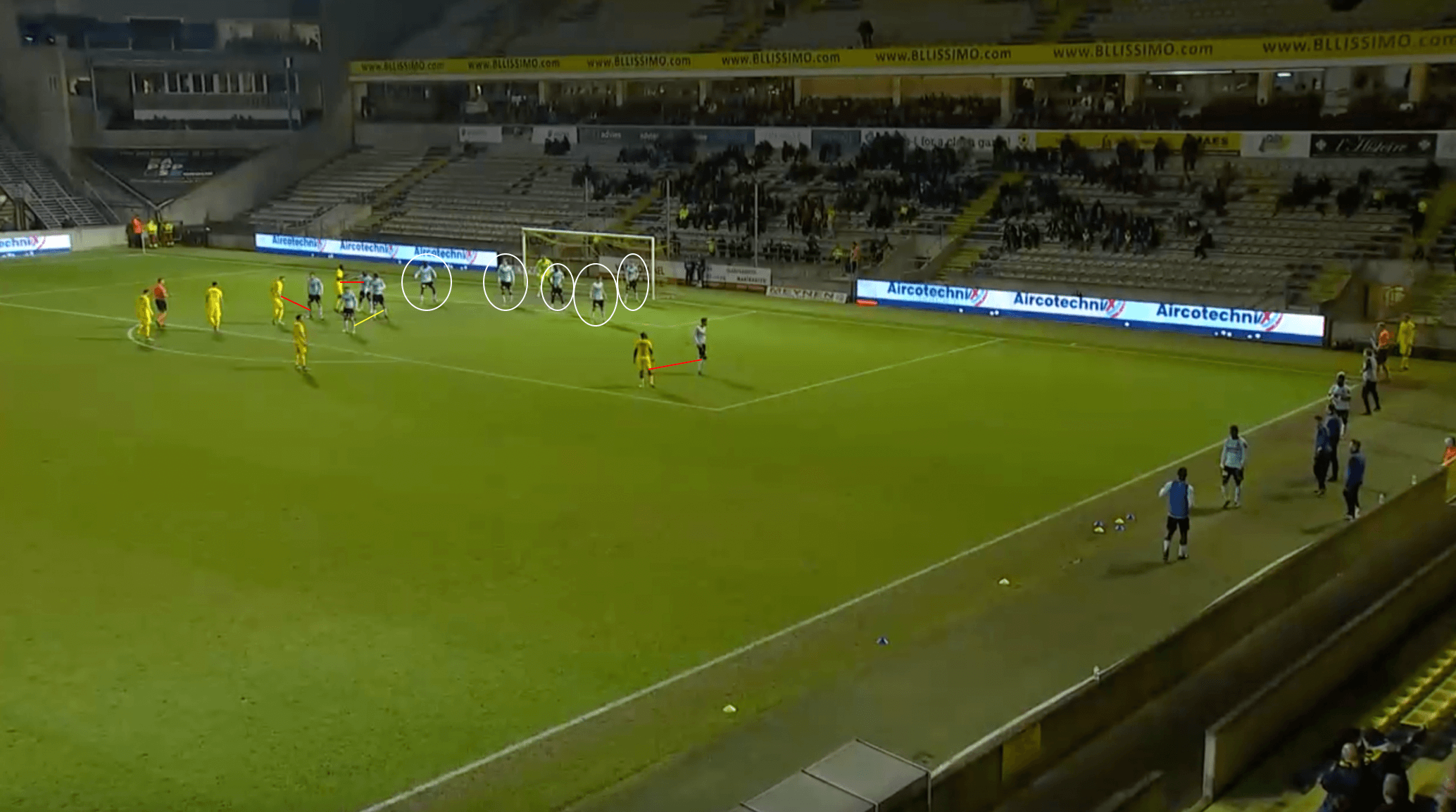
When analysing the corner strategy that Jonas De Roeck has implemented at KVC Westerlo, one can see why it is effective. The first noticeable thing is that all ten outfield players from Westerlo are inside their own 18-yard box. They also deploy a mixture of zonal and man-marking. Four Westerlo players stay in a line on the edge of the six-yard box in front of the goalkeeper with one player staying on the goal line to clear anything that may come to the wrong side of the goalkeeper. Further ahead, three players are man-to-man against their markers (red lines), and two defenders float to cover any late runs from the edge of the box that may occur (yellow line). This setup allows KVC Westerlo to essentially have a second line of defence when defending from corners. If an opposition player gets away from his marker, there will be a defender on the edge of the six that is able to pick them up and stop them from getting a clear chance on goal.
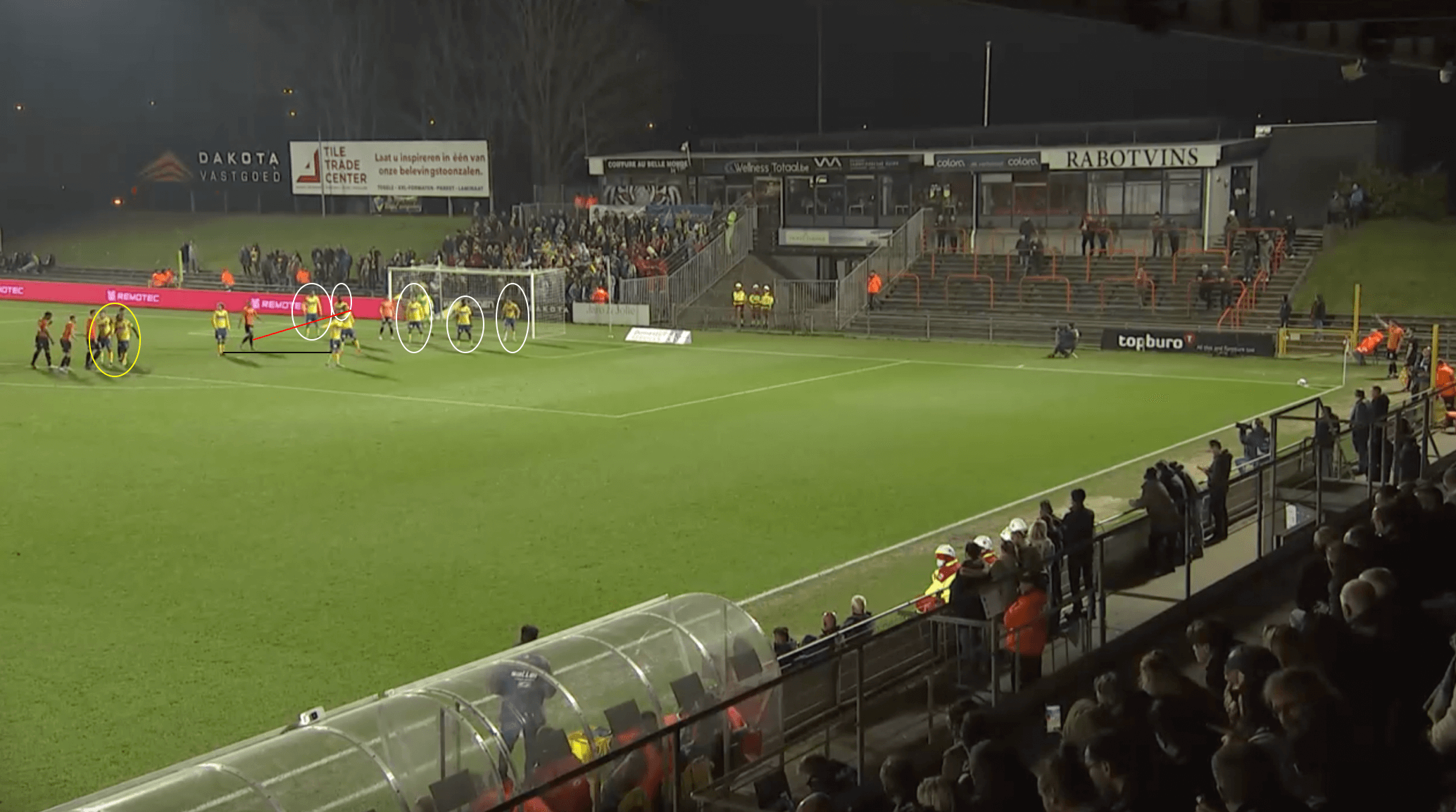
The phase of play above shows another defensive corner setup by KVC Westerlo, this time against K.M.S.K. Deinze. Like the previous example, all 10 outfield players for Westerlo are positioned inside the 18-yard box, with four on the 6-yard line and one covering the ‘keeper’s wrong side. There is, once again, a man-marking matchup (red line), along with two defenders in a zonal system (black line). The two Westerlo players circled in yellow on the edge of the box are also man-marking, with the two zonal players tasked with helping out wherever it is needed. The ensuing ball is sent to the near post but is easily cleared away by the player positioned on the line.
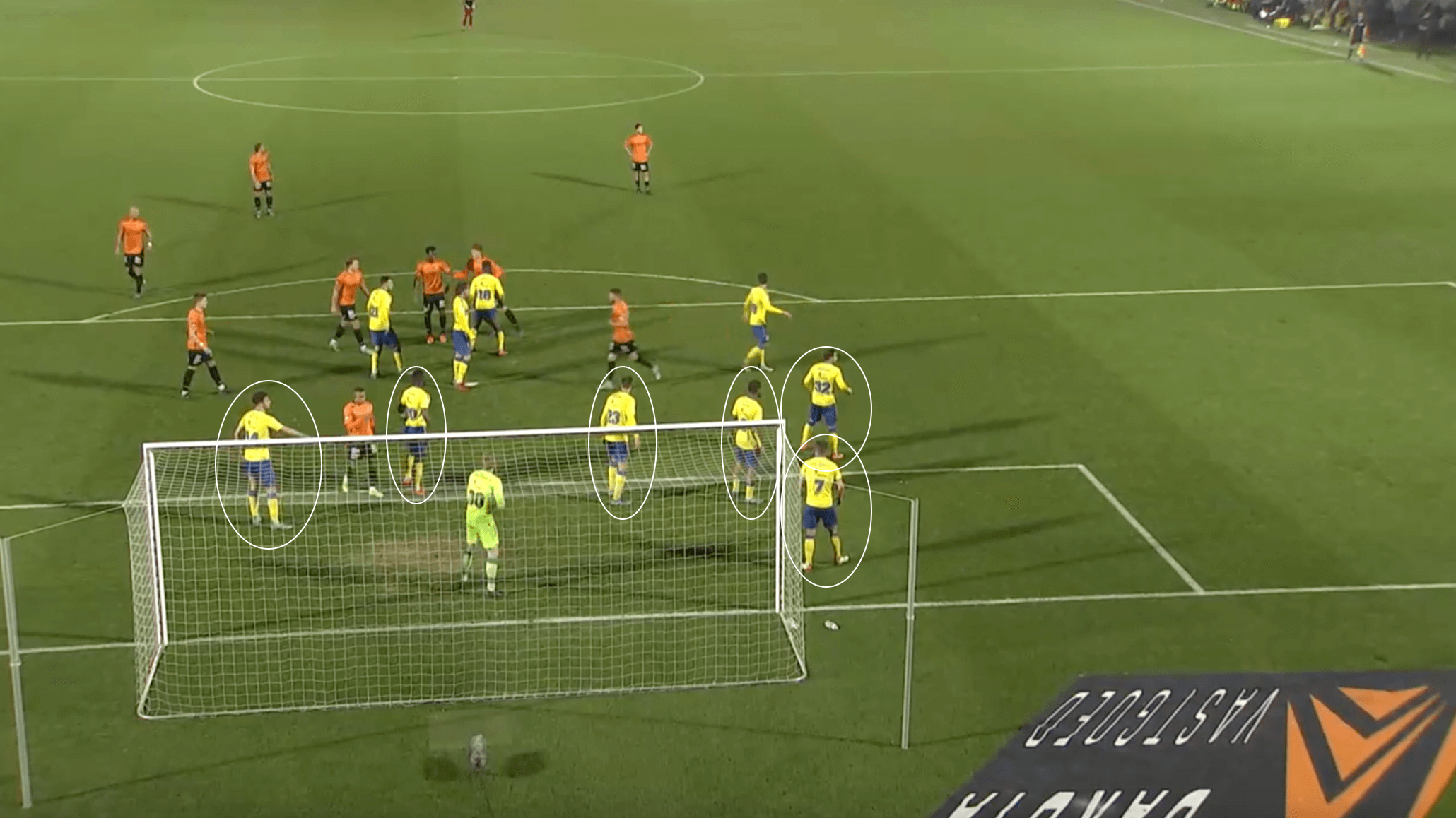
This image from behind the goal shows a better view of this corner defending structure that Jonas De Roeck has implemented at KVC Westerlo. Once again, all 10 outfield players are inside the 18-yard box and defending the corner. Six are positioned in and around the goalkeeper in a zonal marking system. The opposition players attempt to crowd the penalty spot and create picks to get their markers free. However, Westerlo are once again able to utilise a mixture of zonal and man-marking near the penalty spot to prevent an attacker from getting free. As a result, the ensuing corner is cleared away by a Westerlo defender, thwarting the threat with ease.
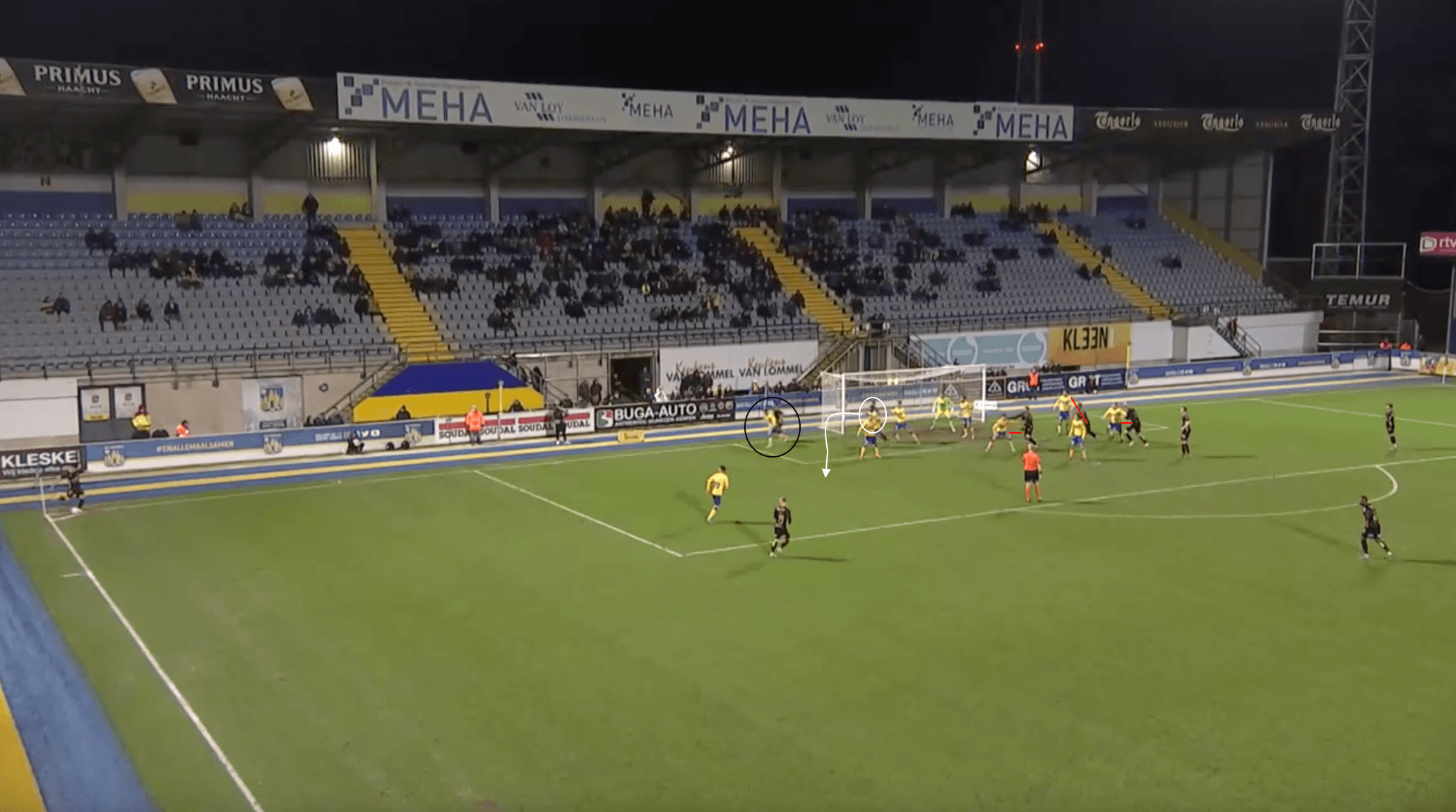
This final example shows a more complex attacking routine that Westerlo had to defend against. Waasland-Beveren attempted to do something different to break down this corner defence. As usual, all 10 outfield players are positioned inside the 18-yard box to help defend this corner. There are three man-marking matchups, circled in red, for Westerlo to mark against. Two Waasland-Beveren attackers position themselves in between the goalkeeper and the players in front of him, attempting to drag them out and make space for deeper runners. The one attacker, circled in black, can drag his marker out of position. The other attacker attempts to make a back-to-front run to try and create the space, but the ensuing corner is once again cleared at the near post.
A former defender himself, it is no surprise that Jonas De Roeck has turned his side into the best team at defending corners in the 1B Pro League this season. This is a vital reason KVC Westerlo find themselves on the brink of automatic promotion back to the Belgian Pro League for next season.
Use of wide play and crossing when attacking
Another trend in Westerlo’s play, this time from an attacking standpoint, is the emphasis De Roeck puts on playing the ball centrally from wide areas. This is shown by the emphasis that KVC Westerlo puts on crossing, with their 500 crosses attempted this season the most in 1B Pro League. This heavy use of crosses in attacking sequences is also illustrated by the number of crosses attempted per 90 by KVC Westerlo, which is 19.69.
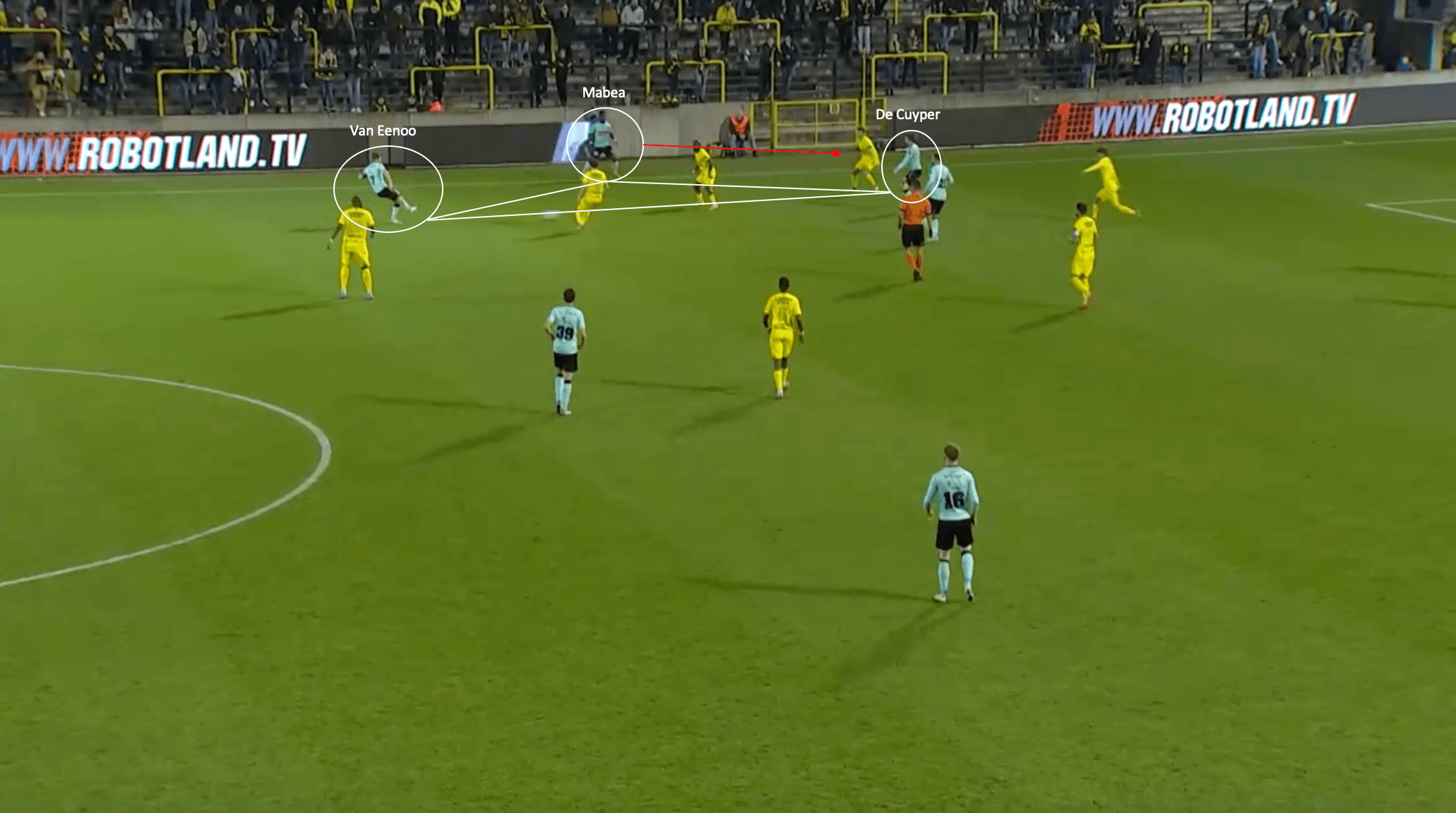
The phase of play above shows one of these attacking sequences by Westerlo from their most recent match against Lierse K. Notice how Westerlo has formed a triangle involving Lukas Van Eenoo, Maxim De Cuyper, and Kouya Mabea on the far touchline. This type of play has been common this season for Westerlo, and it leads to a crossing chance. Van Eenoo plays the ball directly to De Cuyper, who has drifted inside to allow Mabea the space on the flank. As a result, Mabea makes an overlapping run with De Cuyper playing him in. Unfortunately, the cross attempt by Mabea is cleared by a Lierse defender, but the combination play in chance creation shows why Westerlo have had so much success this season from wide areas.
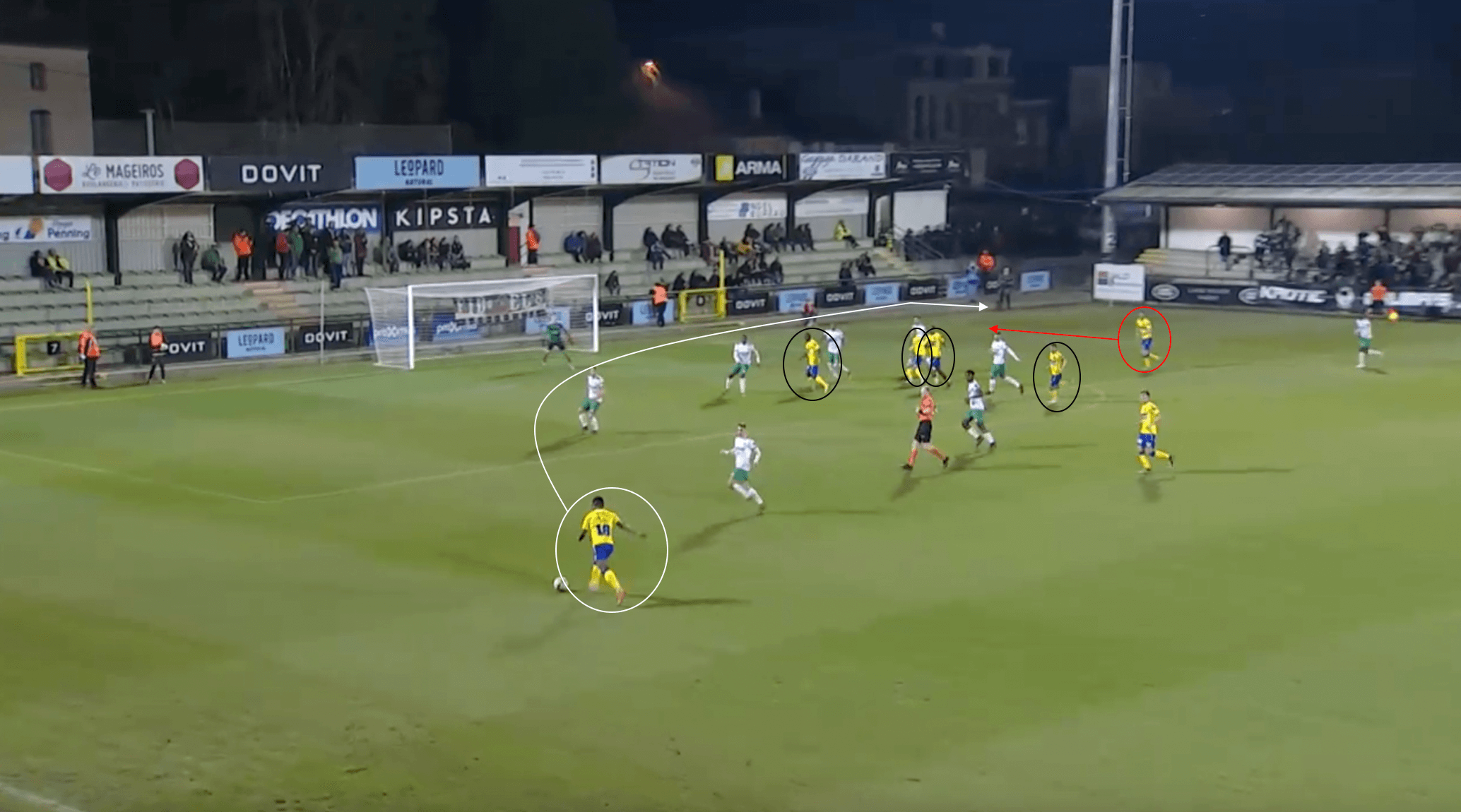
The phase of play above from the match against Excelsior Virton illustrates what makes Westerlo so dangerous when given the time and space to send crosses into the box. The ball is played out wide to the full-back who has space and time to pick out a teammate to cross to. Four Westerlo players have ventured into the box to try and attack the cross. One player can find himself in space at the back post, which the full-back notices. The cross is played to the back post, and the player circled in red can head the ball back across goal to a teammate in the danger area. The ensuing snapshot is on target but blocked away by a defender in front of the goalkeeper.
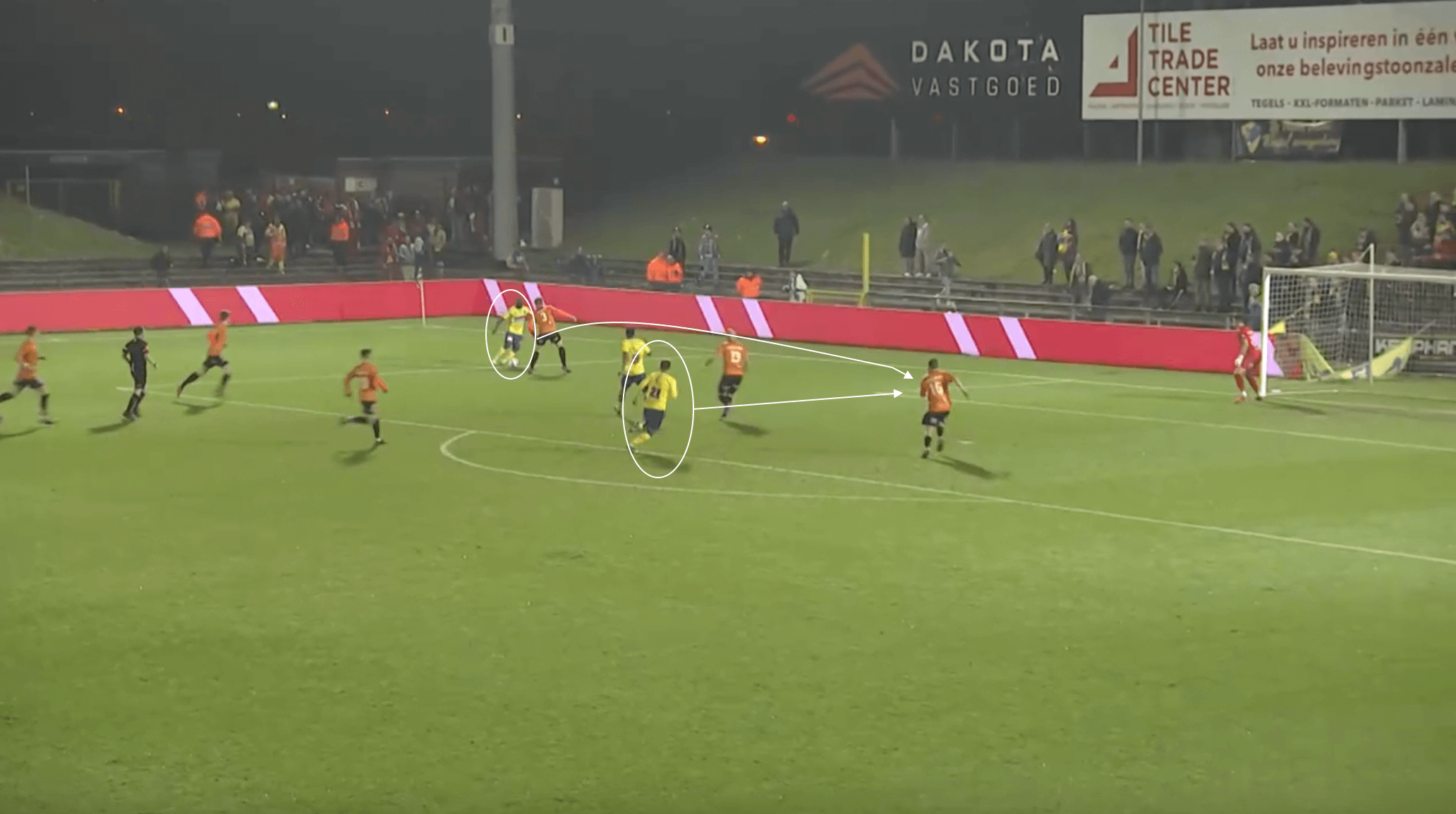
The phase of play above against Deinze shows another attacking sequence where a chance was created from a wide area. The Westerlo player in possession is isolated 1v1 against the Deinze fullback and uses this to his advantage. The defenders are caught ball-watching, which allows the forward to make a run towards the near post unmarked. The player out wide in possession is able to get past the fullback and send a ball towards the near post. Unfortunately, the pass isn’t hit hard enough, which allows the goalkeeper to come out and claim before the forward can reach it. However, this still demonstrates that wide attacking phases are where Westerlo excel. They help them to create goalscoring chances from minimal percentage situations.
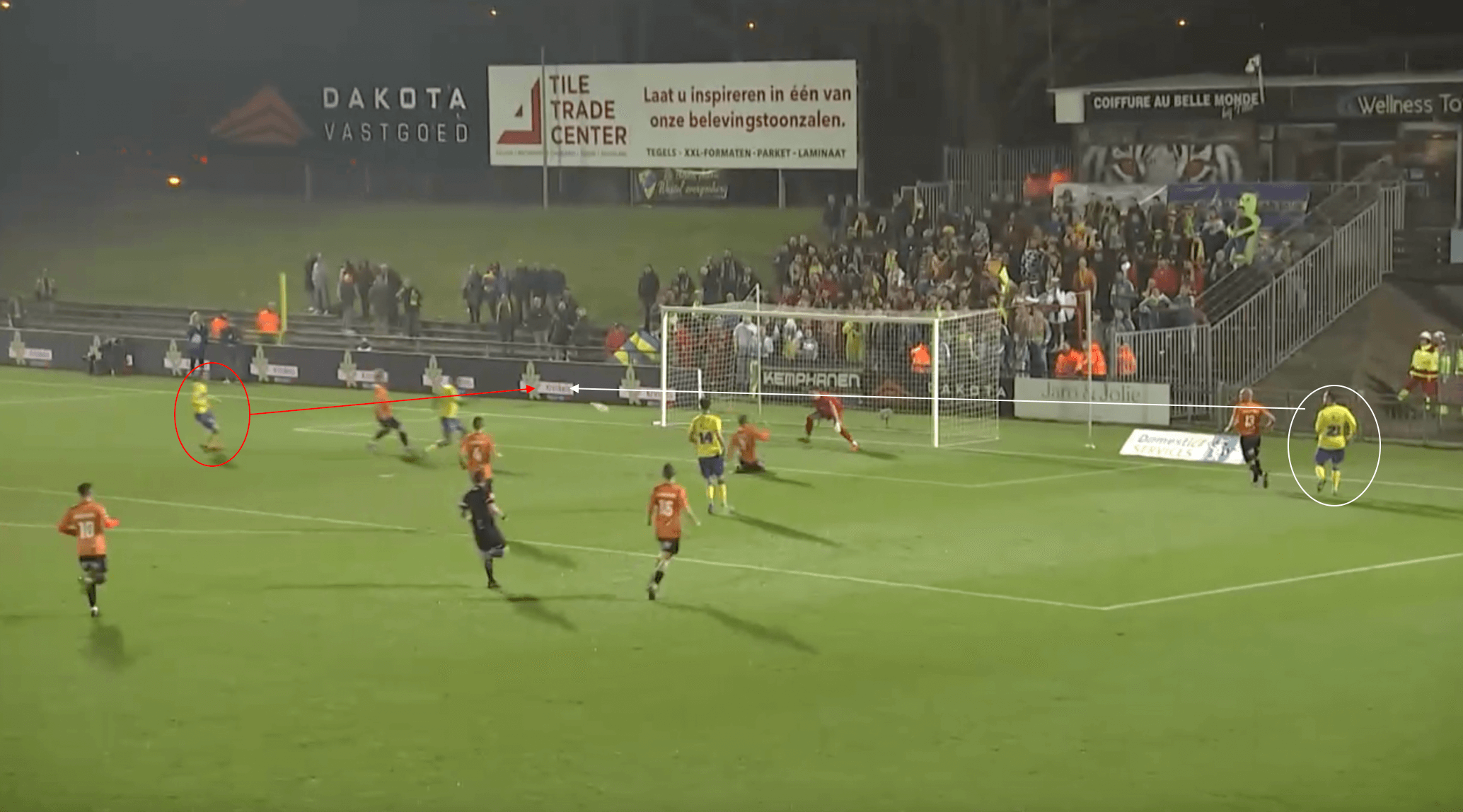
While not all of the crosses played in from the wide areas result in goals, some inevitably do. In the phase of play above against Deinze, a ground cross is played into the box from the right byline. Notice how there are three Westerlo attackers in and around this area as opposed to only two Deinze defenders. As a result of this numerical advantage in Westerlo’s favour, De Cuyper is able to find himself unmarked at the back post to head the ball past the goalkeeper. These tactics of attacking the wide areas and sending crosses into the box have paid dividends for Westerlo this season and provide another reason as to why Jonas De Roeck has them on the verge of winning the 1B Pro League title.
Pressing
Another thing that Jonas De Roeck has done with Westerlo this season: turn them into a pressing machine. When many people think of very good counter-pressing sides, most look towards Liverpool. At Westerlo, De Roeck has essentially made his side the best pressing side in the 1B Pro League this term. Westerlo have a PPDA of 7.9, only trailing Wassland-Beveren’s 7.8 PPDA. This final section will look at Westerlo’s press and why it has been so successful this season.
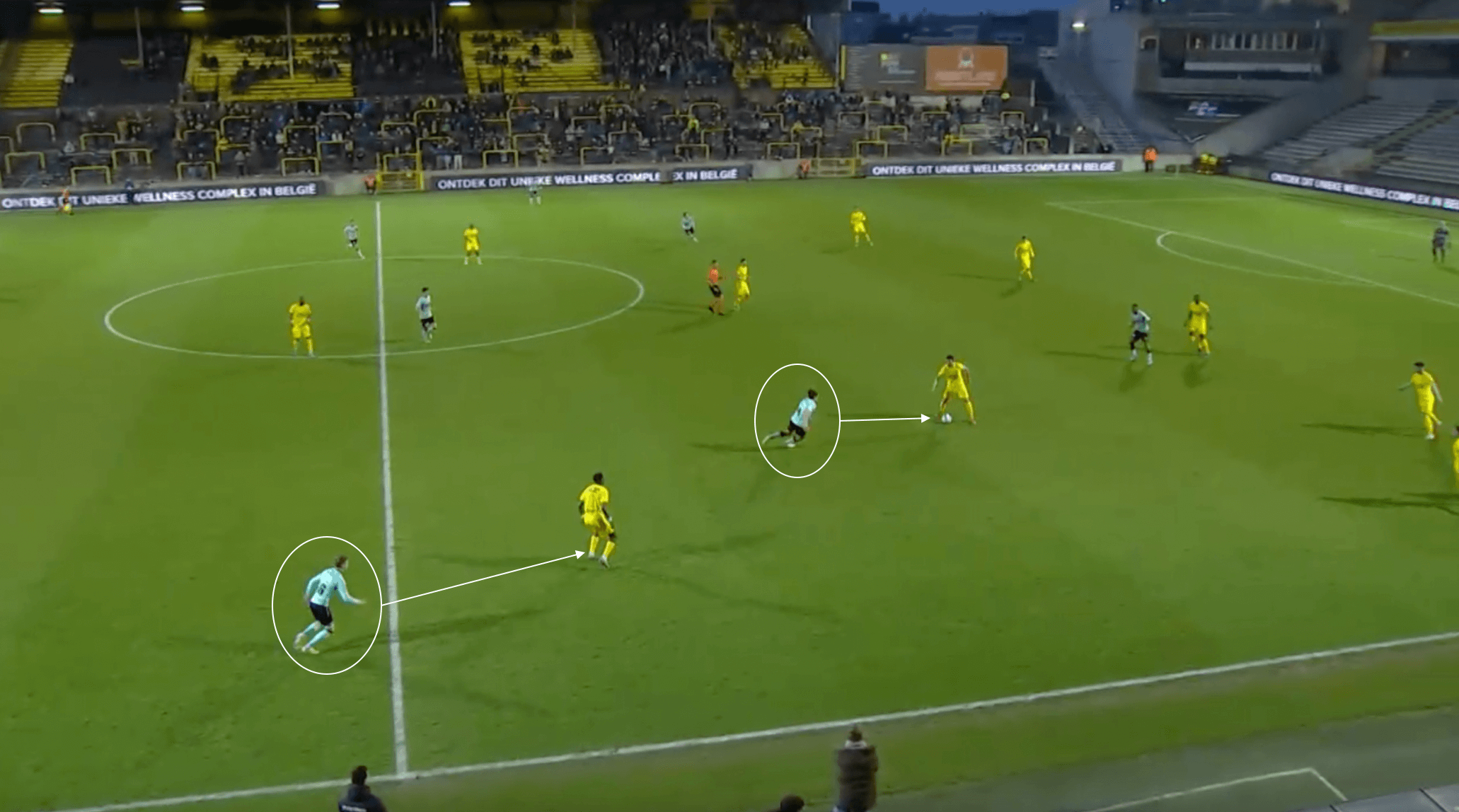
The example of one sequence of this pressing play implemented by De Roeck at Westerlo is shown above. The Westerlo fullback has just made a poor pass, gifting it to the Lierse K. player that is currently in possession. The Westerlo midfielder wastes no time and instantly starts counter pressing the player in possession. Under pressure, the Lierse K. player passes the ball to the more advanced player that is situated close to Westerlo’s fullback. This allows the fullback to make up for his error, as he closes the forward down. He can get a foot on the ball, which sends it back to the Lierse K. backline, who then play it back to the goalkeeper. Westerlo keeps pressing to try and force the goalkeeper into a mistake, which he commits. His resulting clearance sends the ball out of play, allowing a throw-in for Westerlo in an advanced position, something that would not have happened if not for Westerlo’s aggressive counter-pressing.
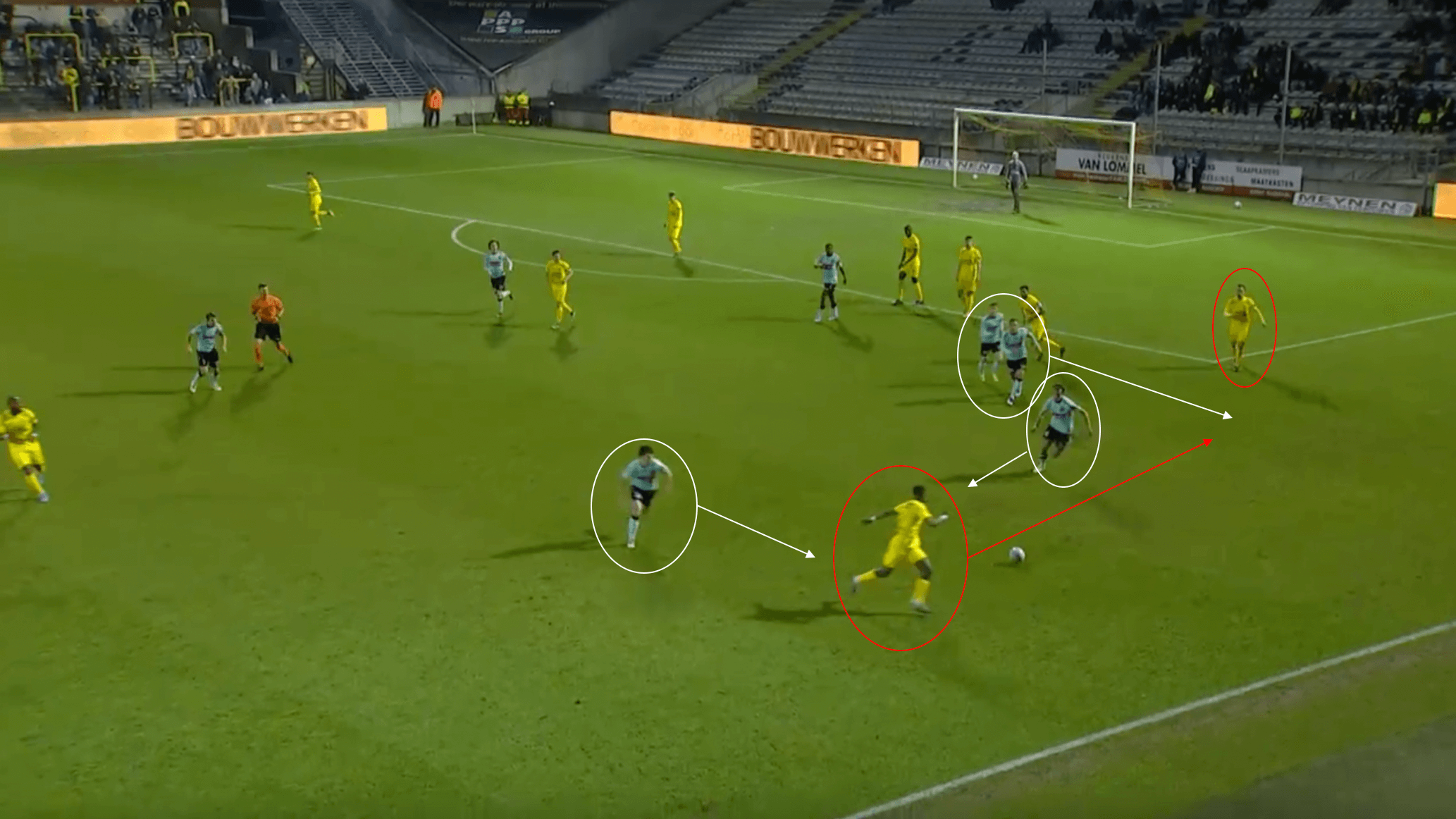
Here is another example of this high octane pressing system from the same match. Westerlo were in an attacking phase but turned the ball over on the edge of Lierse K.’s 18-yard box. As a result, they look for a quick counter-attacking opportunity to try and catch Westerlo out. The ball is played out wide to the player on the near touchline. With this being a counter-pressing trigger, two Westerlo players jump into action to try and win back possession. Crucially, the midfielder presses the ball carrier from behind, which denies him the space to turn and find an advanced runner. His only option is to try and find his fullback, who would be able to punt it long and hope a forward gets on the end of it. Two other Westerlo players notice this and move into the space to intercept the pass. As a result, the counter-pressing is able to lead to a goalscoring chance for Westerlo.
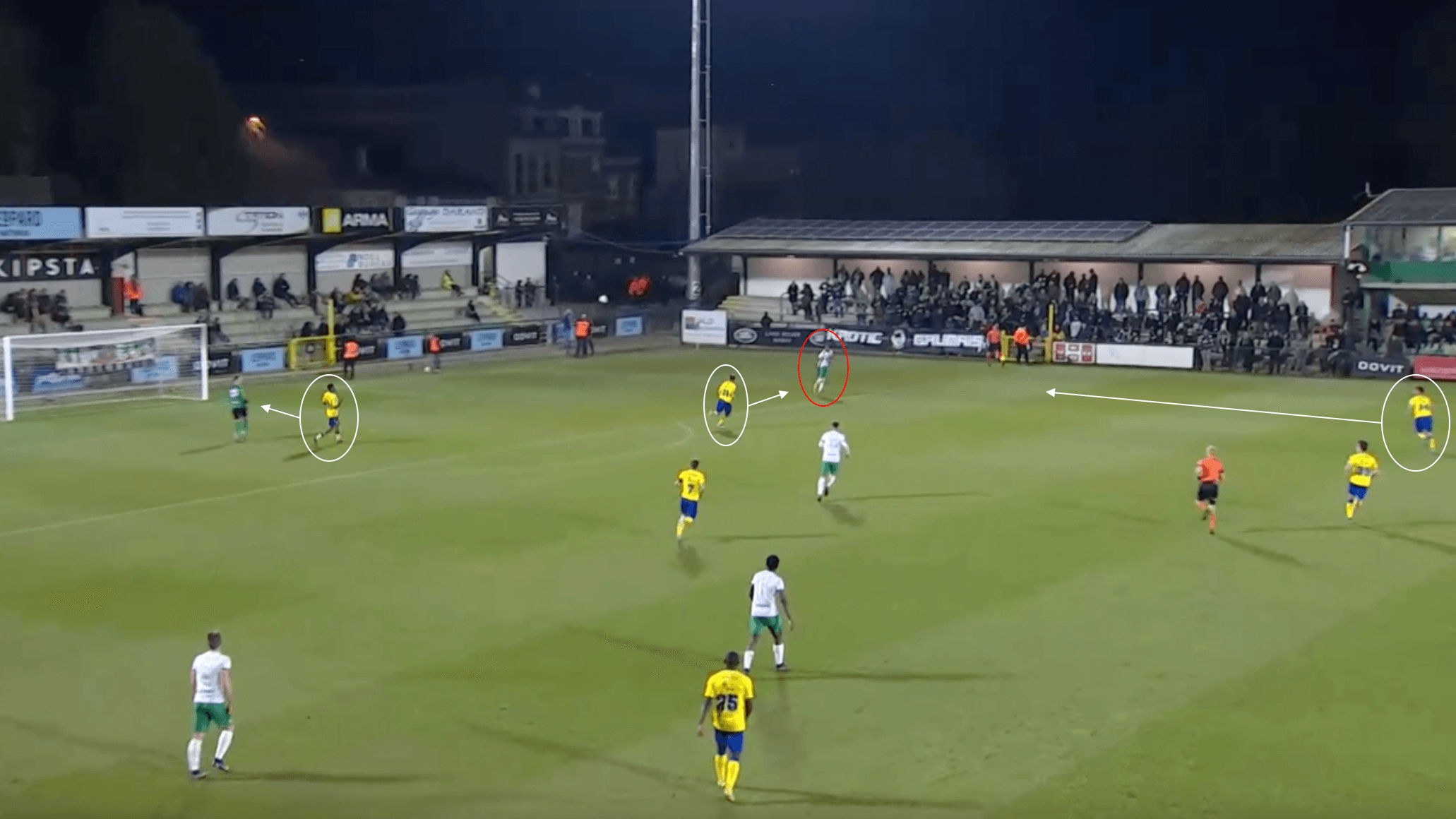
The next image shows an example of Westerlo’s high pressing against Excelsior Virton. However, this pressing phase does not end so well for them. The forward was able to press the goalkeeper, forcing a lobbed clearance to the Virton defender. This triggers the pressing of not one but two Westerlo players. Both can close the defender down, but unfortunately, they collide with each other. This allows another Excelsior Virton player to get on the loose ball and play it over the top to an attacking player making a good run behind the Westerlo defence down the wing. This mistake was not punished by Excelsior Virton but still shows that while Westerlo have one of the best pressing systems in the 1B Pro League this season, errors can still occur.
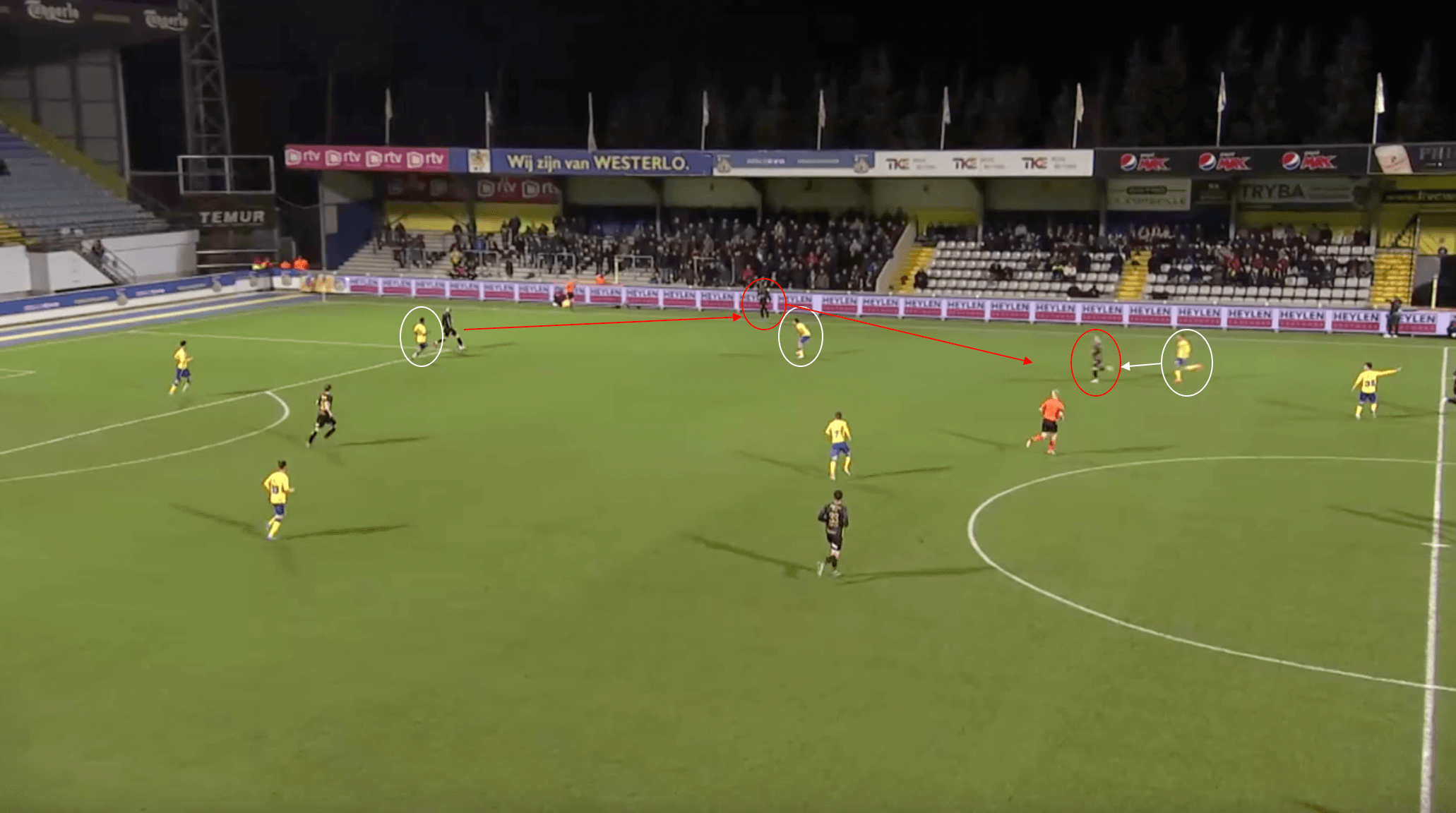
This final example of Westerlo’s pressing under De Roeck comes from their match against Waasland-Beveren. Waasland-Beveren are attempting to build out from the back and Westerlo are engaging in their press. The centre back is being pressed from behind which forces him to send the ball out wide to the fullback on the far touchline. He is pressed and plays the pass to the player dropping deep in midfield. He receives possession but is pressed from behind, forcing a turnover and allowing Westerlo to attempt a counter-attacking sequence.
Conclusion
Under Jonas De Roeck, KVC Westerlo are on the verge of being crowned champions of the 1B Pro League and returning back to the top flight in Belgium for the first time in nearly five seasons. A lot of this success can be attributed to the tactics implemented by De Roeck that this analysis piece has looked at. While it no doubt may be a difficult season if/when the Antwerp-based side return to the top flight, under Jonas De Roeck, the future is bright. The club may look at the success that Union Saint-Gilloise have had in the top flight this season as a blueprint for themselves.





Comments